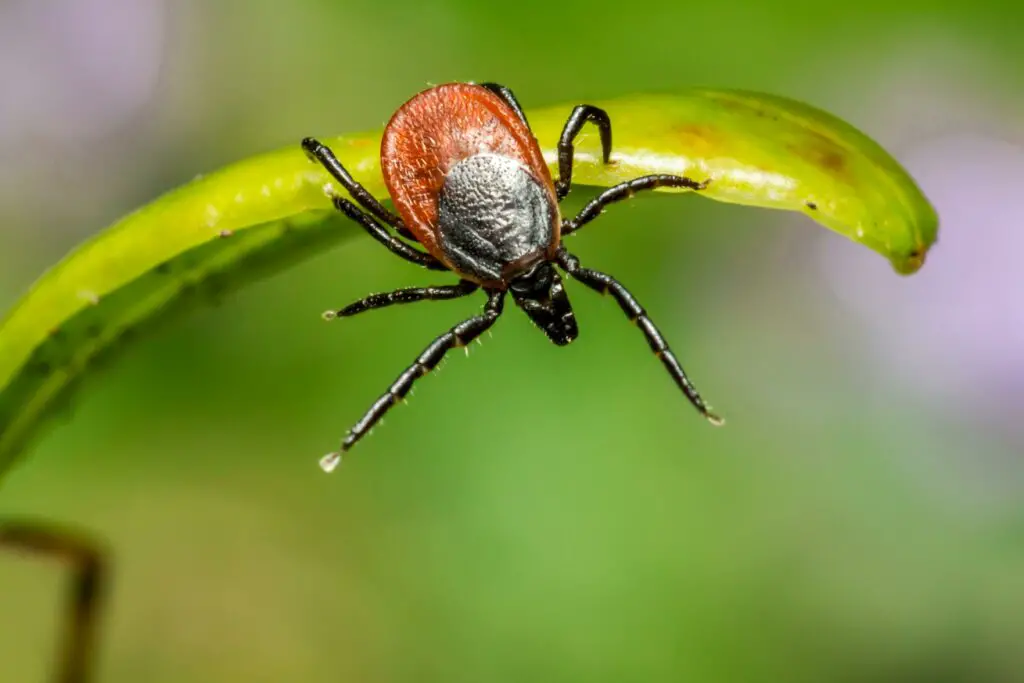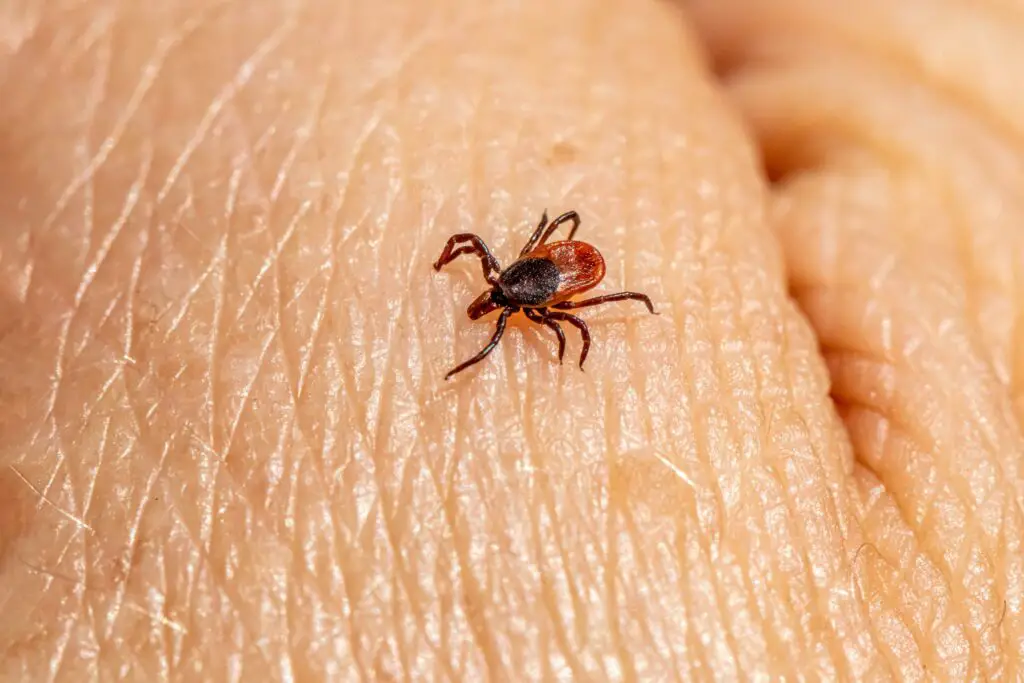Nature is the home to an incredibly versatile array of species, but ticks are definitely one of those that we tend to avoid at all costs.
These tiny arachnids, that are related to spiders, mites, and scorpions, are in fact parasites that survive by attaching themselves to larger animals and feeding on their blood. Humans aren’t spared either. Sadly, these insects carry harmful bacteria that can spread disease to people.
Sadly, tick-borne diseases are at an all-time high, with about 50,000 cases reported each year, and far more going unreported.

There are different types of ticks, and unfortunately, they sometimes find their way to people’s homes. The types most commonly found in homes are the black-legged tick, the dog tick, and the brown dog tick.
- Black-legged Ticks – known as deer ticks, these ticks are typically brown or black in color and have a flattened, oval-shaped body. They are commonly found in wooded areas and can transmit Lyme disease.
- Dog Ticks are larger and can range in color from brown to reddish-brown. They have a tough, shield-shaped body. Dog ticks can transmit diseases such as Rocky Mountain spotted fever.
- Brown Dog Ticks are brown in color and have a slender body.
Although the tick season is between March and October, or sometimes longer, we should be wary of this insects all year round. In fact,if beaten by a tick, a person can develop symptoms even after two or three months.

The bite itself isn’t painful and can cause swelling, itchiness, blistering, and bruising. The bad thing is that ticks also carry and transmit severe diseases, most commonly Lyme disease, as well as Rocky Mountain spotted fever, ehrlichiosis, and babesiosis.
Initially, Lyme disease develops as a circular red ‘bull’s eye’ rash around the site of a tick bite. However, not everyone gets a rash and you should also watch out for a flu-like illness with fever, headache, tiredness and general aches and pains.
The best way to prevent being bitten by a tick is to avoid tall grasses and areas where ticks thrive (such as moorlands and woodlands), especially during the warmer months.
In case you do get bitten, you should remove the tick as soon as possible in order to prevent infections.

These are some of the ways of safe removal.
- Use fine-tipped tweezers: Use clean, fine-tipped tweezers to grasp the tick as close to the skin as possible.
- Pull gently: Apply steady upward pressure, being careful not to squeeze or crush the tick. Aim to remove the tick in one smooth motion without twisting or jerking. Twisting or jerking can cause the tick’s head to break off and stay inside the skin, where it can still transmit disease.
- Clean the area: After removing the tick, clean the affected area with soap and water or an antiseptic solution. Monitor the site of the bite for any signs of infection or a rash, and consult a healthcare professional if necessary.

If by any chance ticks find their way into your home, take immediate action in order to prevent infestation. Most times, ticks are brought into your home in case they stick on your clothes or onto your pets.
- Isolate the area: If you have identified the presence of ticks in a specific area, keep pets and children away from that space.
- Wear protective gear: Put on gloves and a long-sleeved shirt to protect yourself from potential tick bites.
- Clean the area: Clean the area where you found the tick. If it is in bedding, wash the sheets. Inspect the area to ensure there are no more ticks that are present. Dispose of the tick by either flushing it down the toilet or sealing it in a container or ziplock bag before placing it in the trash.
My Wife Gave Birth to a Baby with Black Skin – When I Found Out Why, I Stayed with Her Forever

Brent’s world shatters when his wife gives birth to a baby with dark skin, sparking shock and accusations in the delivery room. As doubt and betrayal threaten to tear their family apart, Brent must make a choice that will test the strength of their love and trust forever.
After five years of trying, Stephanie and I were finally about to be parents. Stephanie’s hand gripped mine like a vice as she rode out another contraction, but her face was serene and focused.

A woman in a hospital bed | Source: Midjourney
Our families hovered near the door, giving us space but staying close enough that they could rush in as soon as the baby arrived.
The doctor gave me a reassuring nod, and I squeezed Stephanie’s hand.
“You’re doing great, babe,” I whispered.
She shot me a quick smile, and then it was time. Time for everything we’d hoped for, worked for, to finally happen.

A woman in labor | Source: Midjourney
When the first cry pierced the air, I felt a rush of relief, pride, and love all tangled together. I didn’t even realize I was holding my breath until I let it out in a shaky exhale.
Stephanie reached out, eager to hold our baby, but as the nurse laid the tiny, squirming bundle into her arms, something in the room shifted.
Stephanie stared at the baby, her face draining of color, eyes wide with shock.
“That’s not my baby,” she gasped, the words catching in her throat. “That’s not my baby!”

A shocked woman | Source: Midjourney
I blinked, not understanding. “What do you mean? Steph, what are you talking about?”
She shook her head, even as the nurse explained that they hadn’t cut the umbilical cord yet, so this was definitely our baby. She looked like she wanted to shove it away.
“Brent, look!” Her voice was rising, panic seeping into every syllable. “She’s… she’s not… I never…”
I looked down at our baby and my world tilted. Dark skin, soft curls. I felt like the ground had just been ripped out from under me.

A newborn baby | Source: Pexels
“What the hell, Stephanie?” I didn’t recognize my voice, sharp and accusing, slicing through the room.
The nurse flinched, and from the corner of my eye, I noticed our families, frozen in shock.
“It’s not mine!” Stephanie’s voice cracked as she looked at me, eyes brimming with tears. “It can’t be. I never slept with anyone else. Brent, you must believe me, I never—”
The tension in the room was suffocating, thick, and choking, as everyone quietly slipped away, leaving just the three of us. I should’ve stayed, but I couldn’t bear the betrayal.

A man in a hospital room | Source: Midjourney
“Brent, wait!” Stephanie’s voice rang out from behind me, broken and desperate, as I marched toward the door. “Please, don’t leave me. I swear to you, I’ve never been with anyone else. You’re the only man I’ve ever loved.”
The raw honesty in her voice made me stop. I turned to look at her. This was the woman I’d loved for years, the woman who had stood by me through every trial and heartbreak. Could she really be lying to me now?

A man glancing over his shoulder | Source: Midjourney
“Steph,” I said, my voice softening despite the storm raging inside me. “This doesn’t make sense. How… how do you explain this?”
“I don’t understand it either, but please, Brent, you have to believe me.”
I looked back at the baby in her arms, and for the first time, really looked. The skin and hair were still a shock. But then I saw it: She had my eyes. And a dimple on her left cheek, just like me.

A cute baby | Source: Midjourney
I closed the distance between us and reached out to cup Steph’s cheek. “I’m here. I don’t know what’s going on, but I’m not leaving you. We’ll figure this out together.”
She collapsed against me, sobbing, and I held my wife and my daughter as tightly as I could. I’m not sure how long we stayed like that, but eventually, Stephanie started to nod off. The long hours of labor and the stress of our baby’s shocking appearance had taken a toll on her.
I gently untangled myself from them and murmured, “I just need a minute. I’ll be right back.”

A man and his wife | Source: Midjourney
Stephanie looked up at me, her eyes puffy and red, and nodded. I knew she was scared I wouldn’t come back, but I couldn’t stay in that room any longer. Not with the way my mind was spinning.
I stepped out into the hallway, the door clicking softly behind me, and sucked in a deep breath, but it didn’t help. I needed more than just air. I needed answers, clarity, something to make sense of the chaos that had just torn through my life.
“Brent,” a voice called, sharp and familiar, breaking through my thoughts like a knife.

A troubled man | Source: Midjourney
I looked up to see my mother standing near the window at the end of the hall, arms crossed tightly over her chest. Her face was set in a hard, disapproving line, the kind that used to send shivers down my spine as a kid when I knew I’d messed up.
“Mom,” I greeted her, but my voice was flat, emotionless. I didn’t have the energy for whatever lecture she was about to deliver.
She didn’t waste any time. “Brent, you can’t stay with her after this. You saw the baby. That’s not your child. It can’t be.”

A woman in a hospital hallway | Source: Midjourney
“She is my child, I’m sure of it. I—” My voice faltered because the truth was, I wasn’t entirely sure. Not yet. And that doubt… God, that doubt was eating me alive.
Mom moved closer, her eyes narrowing. “Don’t be naive, Brent. Stephanie has betrayed you, and you need to wake up to that fact. I know you love her, but you can’t ignore the truth.”
Her words hit me like a punch to the gut. Betrayed. I wanted to shout at my mother, to tell her she was wrong, but the words stuck in my throat. Because some small, cruel part of me was whispering that maybe she was right.

A doubtful man | Source: Midjourney
“Mom, I… I don’t know,” I admitted, feeling the ground start to slip away from beneath my feet. “I don’t know what to think right now.”
She softened, just a little, reaching out to touch my arm. “Brent, you need to leave her. You deserve better than this. She’s clearly not who you thought she was.”
I pulled away from her, shaking my head. “No, you don’t get it. This isn’t just about me. That’s my wife and daughter in there. I can’t just walk away.”

A troubled man | Source: Midjourney
Mom gave me a pitying look. “Brent, sometimes you have to make hard decisions for your own good. You deserve the truth.”
I turned away from her. “Yeah, I do deserve the truth. But I’m not making any decisions until I have it. I’m going to get to the bottom of this, Mom. And whatever I find out, I’ll deal with it. But until then, I’m not giving up on Stephanie.”
She sighed, clearly dissatisfied with my response, but she didn’t push further. “Just be careful, Brent. Don’t let your love for her blind you to reality.”

A woman in a hospital hallway | Source: Midjourney
With that, I turned and walked away. I couldn’t stand there and listen to any more of her doubts, not when I had so many of my own. I made my way down to the hospital’s genetics department, every step feeling heavier than the last.
By the time I reached the office, my heart was pounding in my chest, a relentless reminder of what was at stake.
The doctor was calm and professional, explaining the DNA test process as if it were just another routine test. But for me, it was anything but routine.

A doctor | Source: Pexels
They took my blood, swabbed the inside of my cheek, and promised they’d have the results as soon as possible.
I spent those hours pacing the small waiting area, replaying everything in my head. I kept thinking about Stephanie’s face, the way she’d looked at me, so desperate for me to believe her.
And the baby with my eyes and my dimples. My heart clung to those details like they were a lifeline. But then I’d hear my mom’s voice in my head, telling me I was a fool for not seeing the truth.

A stressed man | Source: Midjourney
Finally, the call came. I could barely hear the doctor’s voice over the roar of blood in my ears. But then the words cut through the noise: “The test confirms that you are the biological father.”
Relief hit me first, like a wave crashing over me, followed by guilt so sharp it made my breath catch. How could I have doubted her? How could I have let those seeds of suspicion take root in my mind?
But the doctor wasn’t finished.

A doctor | Source: Pexels
She explained about recessive genes, about how traits from generations back could suddenly show up in a child. It made sense, scientifically, but it didn’t erase the shame I felt for not trusting Stephanie.
The truth was clear now, but it didn’t make me feel any less like an idiot. I had let doubt creep in, let it poison what should have been the happiest day of our lives.
I made my way back to the room, the results clutched in my hand like a lifeline.

A man holding test results | Source: Midjourney
When I opened the door, Stephanie looked up, her eyes filled with hope I didn’t deserve. I crossed the room in three quick strides and held out the paper to her.
Her hands trembled as she read, and then she broke down, tears of relief streaming down her face.
“I’m sorry,” I whispered, my voice thick with emotion. “I’m so sorry I doubted you.”
She shook her head, pulling me close, our daughter nestled between us. “We’ll be okay now,” she said softly.

A man with his wife and child | Source: Midjourney
And as I held them both, I made a silent vow: no matter what came our way, no matter who tried to tear us apart, I would protect my family. This was my wife and my child, and I would never let doubt or judgment come between us again.
Here’s another story: My mom and I were taking care of my 11-month-old baby boy, Ashton, while my wife was away at work. Yesterday, my wife called to say she’d be home in the morning to see our son. Mom and I froze because we had been keeping a heartbreaking truth about Ashton from her.
This work is inspired by real events and people, but it has been fictionalized for creative purposes. Names, characters, and details have been changed to protect privacy and enhance the narrative. Any resemblance to actual persons, living or dead, or actual events is purely coincidental and not intended by the author.
The author and publisher make no claims to the accuracy of events or the portrayal of characters and are not liable for any misinterpretation. This story is provided “as is,” and any opinions expressed are those of the characters and do not reflect the views of the author or publisher.



Leave a Reply